eTOM框架性介绍概述
eTom过程框架概述上课讲义

eTom过程框架概述eTOM,是enhanced Telecom Operations Map的英文首字母缩写,英文全称为enhanced Telecom Operations MapTM(eTOM),即增强的电信运营图(eTOM),使信息和通信服务行业的业务流程框架。
eTOM现在已经发布到8.0版本。
eTOM不是一种服务提供商的业务模型,它不陈述服务提供商的目标客户、服务提供商所服务的市场、服务提供商前景、任务等。
eTOM是一种业务流程模型或框架,是业务模型策略的一部分,是为服务提供商提出计划。
eTOM是基于TOM(Telecom Operation Map)发展而来的,TOM侧重的是电信运营行业的服务管理业务流程模型,关注的焦点和范围是运营和运营管理,但是没有充分地分析电子商务对商业环境、业务驱动力、电子商务流程集成化要求的影响,也没有分析日渐复杂化的服务提供商的业务关系。
eTOM为把TOM扩展到整个企业架构,并陈述对电子商务的影响。
它消除了TOM中企业管理(公司型)流程、市场营销流程、保留客户流程、供应商和合作伙伴管理流程之间的隔膜等。
eTOM 中的“e”,其含义既深刻而又丰富。
“eTOM”中的“e”常规指“增强”之意,但它却包含了与业务流程框架有关的很多观念,如:企业流程(Enterpriseprocesses),电子商务激活(eBusinessenabled),扩展的(Expanded)每事 (Everything)、每处(Everywhere)、每时(Everytime)等含义。
eTOM是一种业务流程模型或框架,它为服务提供商提供所要求的企业流程,但它不是业务模型。
它不陈述以下策略问题:谁是服务提供商的目标客户,服务提供商所服务的市场是怎样的,以及服务提供商的愿景如何、任务是什么等等。
eTOM 较好地代表了电信运营业的真实世界,很多服务提供商(包括了系统集成商、ASP 和软件供应商)已经在运用eTOM,因为他们在采购软件、设备,以及面对愈加复杂的业务关系网络中与其它服务提供商的接口,都需要行业的标准框架。
eTOM、ITIL和网络资源管理流程

eTOM 、ITIL 和网络资源管理流程一、eTOM 和ITIL 简介(一)eTOM 简介eTOM ,英文全称为enhanced Telecom Operations Map ,即增强的电信运营图,作为NGOSS 的业务视图,由TMF (电信管理论坛)提出的TOM 模型发展而成,2001年出版1.0版本,目前最新版本为2010年8月提交的9.0版本。
eTOM 在整体上被分为3个过程组,分别是战略、基础设施和产品过程(Strategy 、Infrastructure&Product )、运营过程(Operations )和企业管理过程(Enterprise Management ),以及4个水平层次,分别是市场、产品和客户过程、服务过程、资源过程以及供应商/合作伙伴过程。
其概念层框架如下:在概念层框架(即LEVEL0视图)的基础上,逐级进行细化,最终形成4级视图,分别是LEVEL0、LEVEL1、LEVEL2和LEVEL3视图,在此不对细化视图做一一展开。
(二)ITIL 简介ITIL ,英文全称为Information Technology Infrastructure Library,即信息技术基础架构库,由由英国政府部门CCTA(Central Computing and Telecommunications Agency)在20世纪80年代末制订,共有V1、V2、V3三个版本,其中V2应用最广,被誉为IT 服务管理的最佳实践(以下ITIL 均指ITIL V2)。
ITIL 的架构如下图: 客户运营市场,产品和客户服务资源(应用,计算和网络)供应商/合作伙伴供应商/合作伙伴企业管理股东 员工Stakeholders战略,基础设施&产品 图1业务过程框架—Level 0视图其中核心模块为服务管理模块,有服务提供(Service Delivery)和服务支持(Service Support)2个流程组共10个关键流程,以及服务台(Service desk)1个功能。
通信行业eTOM学习笔记
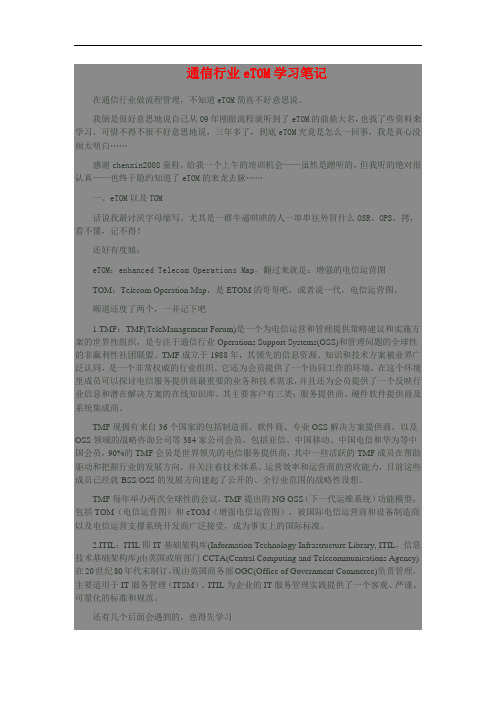
通信行业eTOM学习笔记在通信行业做流程管理,不知道eTOM简直不好意思说。
我倒是很好意思地说自己从09年刚做流程就听到了eTOM的鼎鼎大名,也找了些资料来学习,可惜不得不很不好意思地说,三年多了,到底eTOM究竟是怎么一回事,我是真心没闹太明白……感谢chenxin2008童鞋,给我一个上午的培训机会——虽然是蹭听的,但我听的绝对很认真——也终于隐约知道了eTOM的来龙去脉……一、eTOM以及TOM话说我最讨厌字母缩写。
尤其是一群牛逼哄哄的人一串串往外冒什么OSR、OPS,拷,看不懂,记不得!还好有度娘:eTOM:enhanced Telecom Operations Map,翻过来就是:增强的电信运营图TOM:Telecom Operation Map,是ETOM的哥哥吧,或者说一代,电信运营图。
顺道还度了两个,一并记下吧1.TMF:TMF(TeleManagement Forum)是一个为电信运营和管理提供策略建议和实施方案的世界性组织,是专注于通信行业Operations Support Systems(OSS)和管理问题的全球性的非赢利性社团联盟。
TMF成立于1988年,其领先的信息资源、知识和技术方案被业界广泛认同,是一个非常权威的行业组织。
它还为会员提供了一个协同工作的环境,在这个环境里成员可以探讨电信服务提供商最重要的业务和技术需求,并且还为会员提供了一个反映行业信息和潜在解决方案的在线知识库。
其主要客户有三类:服务提供商、硬件软件提供商及系统集成商。
TMF现拥有来自36个国家的包括制造商、软件商、专业OSS解决方案提供商,以及OSS领域的战略咨询公司等384家公司会员,包括亚信、中国移动、中国电信和华为等中国会员,90%的TMF会员是世界领先的电信服务提供商,其中一些活跃的TMF成员在帮助驱动和把握行业的发展方向,并关注着技术体系、运营效率和运营商的营收能力,目前这些成员已经就BSS/OSS的发展方向建起了公开的、全行业范围的战略性设想。
etom二级流程框架描述
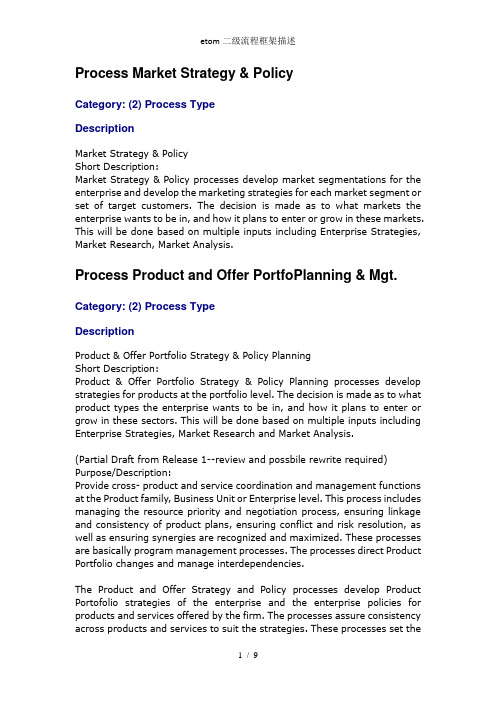
Process Market Strategy & PolicyCategory: (2) Process TypeDescriptionMarket Strategy & PolicyShort Description:Market Strategy & Policy processes develop market segmentations for the enterprise and develop the marketing strategies for each market segment or set of target customers. The decision is made as to what markets the enterprise wants to be in, and how it plans to enter or grow in these markets. This will be done based on multiple inputs including Enterprise Strategies, Market Research, Market Analysis.Process Product and Offer PortfoPlanning & Mgt. Category: (2) Process TypeDescriptionProduct & Offer Portfolio Strategy & Policy PlanningShort Description:Product & Offer Portfolio Strategy & Policy Planning processes develop strategies for products at the portfolio level. The decision is made as to what product types the enterprise wants to be in, and how it plans to enter or grow in these sectors. This will be done based on multiple inputs including Enterprise Strategies, Market Research and Market Analysis.(Partial Draft from Release 1--review and possbile rewrite required) Purpose/Description:Provide cross- product and service coordination and management functions at the Product family, Business Unit or Enterprise level. This process includes managing the resource priority and negotiation process, ensuring linkage and consistency of product plans, ensuring conflict and risk resolution, as well as ensuring synergies are recognized and maximized. These processes are basically program management processes. The processes direct Product Portfolio changes and manage interdependencies.The Product and Offer Strategy and Policy processes develop Product Portofolio strategies of the enterprise and the enterprise policies for products and services offered by the firm. The processes assure consistency across products and services to suit the strategies. These processes set theProduct and Service framework for the enterprise. Both the functional processes, as well as Supply Chain and Infrastructure Lifecycle Management processes, impact the Product and Offer Portfolio Strategy and Policy processes. Some of the best examples are in the area of cost management: -Access cost is huge component of a communications service provider's service cost for many services. The Product and Offer Portfolio Strategy and Policy processes will drive cost reduction strategies in the Supply Chain Lifecycle Management processes.-Unit cost is a key measure for the enterprise of the functional processes. Again, Product and Offer Portoflio Strategy and policy would define key areas for cost reduction that would result in Supply Chain or Infrastructure processes as triggers.New infrastructure capabilities can be a key trigger to mean an entirely new product portfolio. Product and Offer Portfolio Strategy and Policy takes information and analysis from all areas of the business and market information to define product and service portfolio policies that will succeed in the marketplace. Product and Offer Portfolio Strategy and Policy are the driving forces of the enterprise. They drive changes across the operations processes to provide products and services to the customer per their expectations and for what will be competitively successful in the market. These strategies and policies drive infrastructure development and support for the capacity and capability required to provide products and services to customers that meet customer expectations and that will competitively successful. The Product and Offer Portfolio Strategy and Policy processes facilitate priority decisions and cross- product and resource issues and drive their implementation.Process Product & Offer BusinesPlanning & Commit Category: (2) Process TypeDescriptionProduct & Offer Business Planning & CommitmentShort Description:Product & Offer Business Planning & Commitment processes provide cross- product and service coordination and management functions at the Product family, Business Unit or Enterprise level. These processes develop annual and multi-year product and/or offer plans for a product or service that includes product or service forecasts, negotiation for required level of resources, gaining interdepartmental, process, infrastructure and supply chain commitment and executive approval, as well as communicating the plan. The outcome is approved Business Cases which will initiate delivery or development activities.(Partial Draft from Release 1--review and possbile rewrite required) Purpose/Description:Develop annual and multi-year product and/or offer plans for a product or service that includes product or service forecasts, negotiation for required level of resources, gaining commitment and approval, as well as communicating the plan.The product plan is the documentation of the profit and loss commitment to the firm and how it will be achieved. The majority of pricing decisions are set or planned through this process.The Product Plan is the plan of record and commitment to the Business Unit or Enterprise for a product's/service's performance across all key business metrics, customer satisfaction metrics and customer direct measures of quality.Some of the business metrics may include:-Profit Margin-Total and Timing of Revenue-Collectible Percentage-Amount of Discounting-Unit Costetc.Some of the Customer, Direct Measures of Quality may include-Intervals-% Completion on Time-Number of Orders Backlogged-Call Pick-up Time-Mean Time to Repair-Bills Mailed on TimeEtc.Some of the Customer Satisfaction metrics may include:-Satisfaction with service delivered-Knowledge of contact associate-Courtesy of contact associateEtc.The Product Plan should not be viewed as a static document or process. It should have an update process with a start and end that keeps it vibrant andtimely.Business Rules:Level of Approval RequiredCommitment Level RequiredSpecific Schedule AdherenceRevenue, Unit and Unit Cost forecast elements requiredDirect and Indirect cost handlingTax handlingStarts with (pre-condition):Beginning of planning cycle or plan update requiredInput/From:Inputs include: forecasts, product improvement ideas, unit cost targets, revenue targets, new products or feature ideas, process improvement ideas or plans, budget envelopes, timelines, etc.All processes and/or organizations required to directly support the product or service input to the product plan. This process is usually executed at an individual product or service level. The processes may have some elements handled at a more global, e.g., product family. In large service providers an aggregated planning function may be involved that brings together requirements for products or services to drive change and commitment from another process. This could be aimed at the Infrastructure Lifecycle Management processes, a particular supplier or partner, etc.Review and approval/ManagementCommitment/Process and/or organizational managementOutput/To:Requests for input, plans, recommendations, forecasts, negotiation, commitment and approval to other processes and organizations Forecasts and Targets to Sales organization for revenue. In enterprises that have made progress with CRM, revenue targets may be provided for other functions as well, e.g., billing or account inquiry or problem handling.Unit cost targets/ all key organizations supporting the product directly Ends with (post-condition):Committed, Approved and Communicated PlanUpdates as product plan is executed should and do occur.Process activities or steps:See process flow once developed.Functions:Many functions across the enterprise have to support Product Planning, e.g., Financial Management, CRM Planning and Development, Service Planning and Development, Resource Planning and Development, Marketing, Supplier/Partner Planning and Development processes. Product and Offer Management and Development manage the process, but are also accountable for many inputs to the process, many activities within the process and utilized many of the outputs of the process.Product and Offer Planning and Commitment processes are usually done in a product team approach.Information Required:Revenue and Unit Actuals and ForecastsMarket Research DataCustomer Satisfaction DataProcess Performance DataHeadcount, budget and unit cost forecastsRequirements:To be developed at a later dateHints: Not applicable at this levelReference/source:NoneAccountable: Product Management and DevelopmentProcess Product & Offer Capability Delivery Category: (2) Process TypeDescriptionProduct & Offer Portfolio Capability DeliveryShort Description:Based on the Product strategy for the enterprise, the Product & Offer Portfolio Capability Delivery processes manage the delivery and build of new or changed Product capabilities e.g. Third-generation Mobile Telephony national NetworkProcess CRM Capability DeliveryCategory: (2) Process TypeDescriptionCRM Capability DeliveryShort Description:Based on the Market and Product strategy for the enterprise, the CRM Capability Delivery processes manage the delivery and build of new or changed CRM capabilities e.g. ability to identify, save, manipulate and retrieve and apply new types if knowledge about customersProcess Product Development & Retirement Category: (2) Process TypeDescriptionProduct Development and RetirementShort Description:Product Development and Retirement processes develop and deliver new products or services and product or service enhancements and new features ready for implementation by the Operations processes. Product Development and Retirement processes are project oriented, as ongoing Product Management is a process within Operations. The key measures of this process are how effectively are the enterprise抯products and services broadened and the time to market for new products and services or features. These processes also manage major product and service updates and enhancement. Business Case development tracking and commitment are key elements of this process, as are project management discipline with defined quality gates.Process Sales and Channel DevelopmentCategory: (2) Process TypeDescriptionSales & Channel DevelopmentShort Description:Sales & Channel Development processes develop the Sales and Channel support and response for new and existing products and services, as well as existing and potential customers. Sales Development is heavily related to Sales Management in the Operations process area. Sales Development processes develop product related compensation plans, define product revenue targets, develop product related sales training, develop prospect identification methodology, develop selling processes/methods and procedures for new products. Channel Development processes define channels for selling the enterprise抯products. It develops or ensures development of channel ability to sell and support products. Channel Development processes include negotiating for the specific channel, defining or updating the account management process, developing pricing for a specific channel, etc.Process Marketing Communications & Promotion Category: (2) Process TypeDescriptionMarketing Communications & PromotionShort Description:Marketing Communications & Promotion processes deal with overall communication to customers and markets. Marketing Communications processes develop and manage communications to the market, prospects and existing customers. Communications involves both the message and the media. Marketing Communications can develop a message and manage its delivery through a bill insert, phone communication with customers and/or a magazine ad. Marketing Communications develops and manages interfaces with press/news, e.g., schedules press interviews, manages an editorial calendar to plan placements, etc.Marketing Promotion on the other hand is the development of specific promotions to sell products, retain customers, and bring in new customers. Marketing Promotion processes create the promotional campaigns and advertising to reach the market, customers and channels. They develop the campaigns and collateral, whether direct mail, newspaper ad, etc. Marketing Promotion processes work with all other processes of Marketing, Sales and Offer, Brand Management, Market Research and Advertising Management todesign marketing promotions and advertising, to determine trade show participation and presence, to support product introductions, etc. Marketing Promotions processes interface with Marketing Fulfillment Response processes in Customer Relationship Management to execute the campaign. One of the key roles of these processes is to position the product in the market, especially versus competitive products.(Partial Draft from Release 1--review and possbile rewrite required) Purpose/Description:Marketing Communications and Brand Management processes are heavily tied to Marketing Promotion processes. They are a higher level from some of the other Marketing, Sales and Offer Management processes because they deal with overall communication to customers and markets. They also deal with plans and approaches to brand management. For example, Offer and Product Management processes usually have to have Brand Management approval for new products or promotions that may impact the image of the brand. Brand Management develops and delivers, through Marketing Promotions process, brand advertising.Process Product Management & Development Asses Category: (2) Process TypeDescriptionProduct, Marketing & Customer Performance AssessmentShort Description:Product, Marketing & Customer Performance Assessment processes assess whether the Marketing & Offer Management processes are meeting their goals of delivering changes and improvements to the CRM Processes.★★★★★★★★★★★★★★★★★★★★★★★★★★★★★★★★★★★★★Process CRM Operations Support & Process Manag Category: (2) Process TypeDescriptionCRM Operations Support & Process ManagementShort Description:CRM Operations Support & Process Management processes monitor and control the CRM processes, from a general, a cost, a Quality Performance and an Assurance point of view. These processes also ensure the operability of the required IT and Communications Systems, and the Workplace facilities in support of CRM processes. They also include assuring that staff schedules are adapted to the day-by-day requirements of operations, as well as providing general support for the personnel.。
etom业务模型简介

1引言目前,世界各地很多服务提供商采纳了TM论坛的TOM2.1业务架构模式,TOM已经成为服务提供商运营管理的工业标准。
但是,TOM存在两点不足之处:TOM只包含了运营管理过程,而没有覆盖整个企业的业务过程;TOM没有充分考虑到电子商务和Internet对业务环境的影响以及运营商业务关系的越来越复杂性。
针对于此,ETOM以TOM为核心,对这两方面进行了扩展。
具体的讲,ETOM对TOM有以下改进之处:●范围扩展到整个的企业流程;●由于营销过程在电子商务中的重要性,明确标识了营销过程;●明确了企业管理过程;●为了强调客户优先的过程,将实施、保障、计费(Fulfillment、Assurance、Billing,FAB)引入高层视图;●定义了运作支持和条件准备垂直过程组(Operations Support &Readiness,OSR),可应用在除企业管理(Enterprise Management Processes,EM)的所有功能层。
为了集成电子商务,使得客户能够进行自我管理,企业必须对那些使得客户直接操作的、在线的运营过程成为可能的过程(即OSR)进行深入的了解;●标识了战略、基础设施、产品过程(Strategy、Infrastructure and Product,SIP),并将其分为三个垂直的过程组:战略(Strategy&Commit,SC)、基础设施生命周期管理(Infrastructure Lifecycle Management,ILM)、产品生命周期管理(Product Lifecycle Management,PLM)。
这些过程组与运营过程(OPS)具有不同的时间周期,OPS通常是每天的或每分的,而SIP通常具有较长的时间周期;●由客户关怀或面向服务的方式转化为客户关系管理(Customer RelationshipManagement ,CRM)。
CRM强调以下几个方面:客户的自我管理和控制,增加有价值客户对企业的贡献;利用信息来为客户提供个性化服务。
eto企业组织架构

eto企业组织架构一、引言随着经济的不断发展和企业规模的不断扩大,企业组织架构的设计和优化变得越来越重要。
eto企业作为一家新兴的科技公司,也需要一个合理的组织架构来支撑其发展。
本文将就eto企业的组织架构进行详细介绍。
二、eto企业的组织结构eto企业的组织结构主要分为三个层次:高层管理层、中层管理层和基层员工。
1. 高层管理层高层管理层是eto企业决策层,包括董事长、总裁等。
他们负责制定企业的战略目标和发展方向,并制定相应的政策和决策。
高层管理层需要具备丰富的行业经验和战略眼光,能够对企业的未来发展做出准确的判断和决策。
2. 中层管理层中层管理层是eto企业的中间管理层,包括各部门的经理和主管。
他们负责具体部门的日常管理和业务运营,需要协调各部门之间的工作,保证企业的运转顺利。
中层管理层需要具备良好的沟通与协调能力,能够对下属员工进行有效的管理和指导。
3. 基层员工基层员工是eto企业的生产力,包括研发人员、销售人员、客服人员等。
他们是企业的主力军,直接参与到产品的研发、市场推广和客户服务等工作中。
基层员工需要具备专业的技能和知识,能够胜任自己的工作,并保持高效率和创造力。
三、eto企业的组织职能eto企业的组织架构是为了实现企业的战略目标和发展需求而设计的,不同部门承担着不同的职能和责任。
1. 研发部门研发部门是eto企业的核心部门,负责产品的研发和技术创新。
研发团队由一群技术专家组成,他们将不断探索和研究新的科技领域,为企业的产品提供持续的创新动力。
2. 销售部门销售部门是eto企业的市场拓展和销售推广的主要力量。
销售团队通过与客户的沟通和交流,了解客户的需求,提供合适的解决方案,并促成销售交易的完成。
3. 市场部门市场部门负责eto企业的市场营销活动。
他们通过市场调研和竞争分析,制定市场营销策略,提高品牌知名度,并吸引更多的潜在客户。
4. 客服部门客服部门是eto企业与客户之间的重要桥梁,负责处理客户的问题和投诉。
(运营管理)电信运营支撑系统演变过程及概述
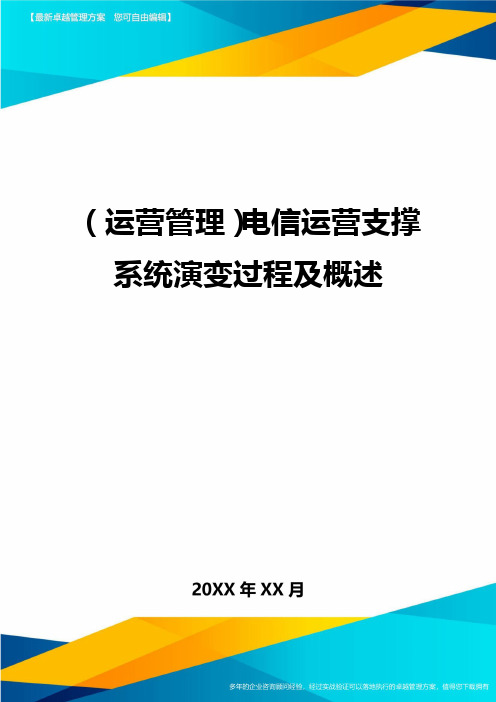
(运营管理)电信运营支撑系统演变过程及概述电信运营支撑系统演变过程及概述第一章:电信业务运营支撑系统概述0、序言1、电信业务运营支撑系统概述电信管理网(TMN)结构及演进2、电信运营及模型(TINA)3、电信管理论坛(TMF)与电信运行图(TOM/eTOM)4、国内电信业务运营支撑系统现状0、序言什么是电信运营:电信运营商利用自身的通信资源,提供给消费者通信服务,而获取利益。
运营的含义:网络和业务的运行、维护及经营。
电信运营的目的:提供更加优质的服务,获取更高的收益。
什么是电信服务?:网络服务,网络承载的基本业务、业务平台提供的增值业务,打包的电信产品(套餐),外包服务,。
什么是电信运营支撑系统?采用计算机的技术,支持电信业务的运营过程的计算机系统。
所引出的问题:如何“更快、更高、更准”:通信技术的不断进步;如:3G/Wimax、宽带技术,如何更好地分析、认识、挖掘市场,如何更准确地计量,如何更快地将电信服务交付给用户,同时、涉及到电信公司本身如何有效地管理。
电信运营支撑系统的特点:复杂、庞大,分布、协同、跨部门,异构研究电信运营支撑系统的意义:任何行业和领域都面临信息化建设的问题—共性问题—业务支撑,计算机应用的根本问题,促进计算机技术的发展—计算、软件1、电信业务运营支撑系统概述电信管理网(TMN)结构及演进电信业务运营支撑系统的概念目前在业界比较混乱,有多种定义如下:电信运营支撑系统OSS (Operating Support System),电信业务支撑系统BSS (Business Support System),电信业务运营支撑系统(BOSS),出于中国移动的概念其中:业务(business)源于TMN的术语。
目前国际上比较公认的叫法:OSS/BSS电信业务运营支撑系统(OSS/BSS)定义:是以市场为导向,面向电信业务和网络的运营支撑以及面向客户服务的企业经营支撑的计算机信息处理和管理系统。
ETOM3.0
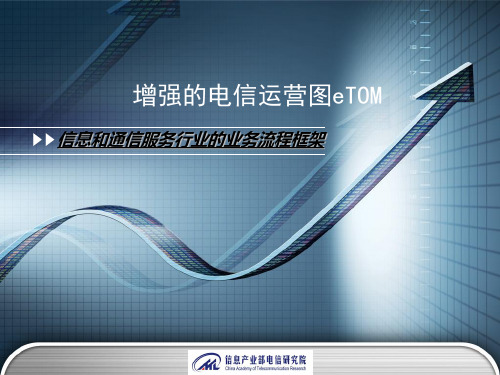
eTOM
业务流程蓝图
BSS
业务支撑系统
OSS
运营支撑系统
30
总结
eTOM-enhanced Telecom Operations Map TMF 电信管理论坛 NGOSS 下一代运营系统和软件
31
eTOM不是什么? eTOM是企业业务流程框架,它为服务提供商提供所要求 的企业运作流程,而不是业务模型。 eTOM不涉及以下问题:谁是服务提供商的目标客户,服 务市场如何,服务提供商的愿景如何,使命是什么等。
提供商 服务提供商 客户
客户
提供商
客户
服务提供商
CRM:客户关系管理 S/PRM:供应和合作伙伴关系管理
图16 利用ETOM业务关系上下文模型和业务过程框架描述服务提供商的关系
19
eTOM定义
eTOM
e=enhanced 增强的
+enterprise process
流程驱动
+eBusiness enabled 强调电子商务的影响
V.企业效率管理 V-1. 企业 质量 管理 V-2. 流程 管理 V-3.IT 规划
VII.外部关系管理 VII-1. VII-3. VII-2. 公共关 政府监 股东关 系(媒 管和法 系管理 体管理 律法规
9
OPERATION 运营
10
1920-1960 Long distance operators, The supervisor was on roller skates so she can get around the large room more quickly to assist the operators.
员工
Stakehol ders
电信运营支撑系统的组成

运营支撑系统的组成目前,各电信运营企业都建有大量系统,覆盖业务运营、客户服务、市场营销、经营分析、网络管理以及企业管理各个方面。
总的来看,各电信运营支撑系统一般都包括业务支撑系统(BSS)、网管支撑系统(OSS)与管理支撑系统(MSS)(如图1所示)。
图1 运营支撑系统组成从系统部署来看,目前各大运营企业都以集团与省公司为主要的建设与管理维护单位,建成了集团与省两级模式的支撑系统。
集团公司的系统主要提供面向全公司的企业管理、经营分析等功能;省公司从职能管理单位逐步转向了兼顾管理、生产的单位,具有了越来越多的生产职能,在运营支撑系统建设中的作用较为突出,一般情况下,在遵循集团公司的总体指导思想下,可自行规划与建设本省的支撑系统;市公司的生产职能有所削弱,主要负责市场营销、客户支撑以及设备的现场维护等工作,因而主要是支撑系统的使用单位。
现有系统的支撑能力为企业的运营管理过程提供支撑能力是建设运营支撑系统最重要的目的。
eTOM模型通过分层与端到端的理念,较为完整地刻画了电信运营的全部过程(如图2所示)。
图2 eTOM框架模型示意图总的来看,现有系统基本覆盖了eTOM各个功能点,实现了市场/客户、业务、资源(基础电信网络、计算资源及业务平台)和企业管理等功能。
在市场与客户支撑方面,各运营商为客户提供了客服电话(中国电信的10000系统、中国移动的10086系统、中国联通10010系统)、网站和短信等多种接入形式,通过各类渠道接受客户的投诉、业务咨询和建议;某些运营商还建设了客户关系管理、经营分析等系统,能够对客户行为、企业经营状况等进行深入分析,为企业决策提供科学依据。
在业务运营与管理方面,现有的业务支撑系统涵盖了对个人客户及集团客户的计费、结算、账务、营销、客户服务、信息服务等内容,实现了对客户、产品(语音以及各类数据产品)、市场营销、渠道的管理,能够有力地支撑企业经营决策,并能够根据业务需要与相关外部系统进行互联。
IT支撑系统基础-金敏玉
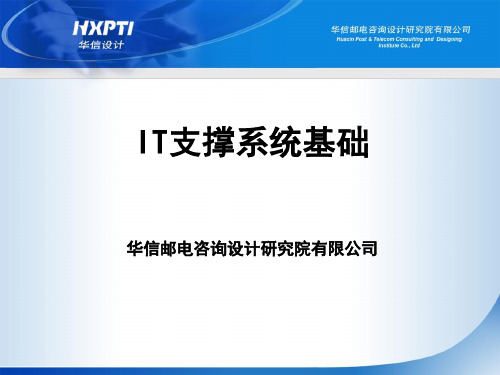
32口 FC Switch
FC光纤
心跳
Portal服务器 搜索服务器 应用服务器
心跳
心跳
WPS服务器IBM P670(分三个区) PORTAL服务器
数据库服务器 P670 GE光纤
省公司OA服务器P550*2
地市分公司OA服务器P570*2
Catalyst 4506(1)
Catalyst 4506(2)
运营分析域
经营分析 运营分析 管理分析
客户运营域
市场 销售 订单 客户服 渠道 管理 管理 管理 务管理 管理 业务资 产品 客户 融合计 综合 源管理 管理 管理 费帐务 结算
管理 信息 系统
决策支持
交 换 平 台
合作伙伴 客户服务 系统
B省/集团 客户 运营域
B2B 集 成 平 台
运营管理域
收入保障 知识管理 人员管理 运营监控管理
呼转中继
PLMN PLMN
DCN
学院路1号楼设备机房
RSA 模块
排队机A
E1
IVR 服务器
VP/FP/CP
HR自助 邮件审批 财 务 管 理
H R 管 理 物 流 管 理 IB AS 展 示
内容应用聚集/EAI OA扩展应用
办 公 用 品 申 领
资 源 预 定
文 档 管 理
搜 索 引 擎
...
电 子 招 投 标
网 上 教 育
知 识 管 理
统 计 查 询
MIS/ERP
财 务 管 理
人 力 资 源 管 理
安 全 管 理 平 台
客户服务
工作管理 任务管理 营销服务管理 组织结构管理 渠道人员管理 渠道规划管理 渠道资料管理
【TMFeTOM】业务流程框架介绍

【TMFeTOM】业务流程框架介绍TMF⽂档版权信息Copyright © TeleManagement Forum 2013. All Rights Reserved.This document and translations of it may be copied and furnished to others, and derivative works that comment on or otherwise explain it or assist in its implementation may be prepared, copied, published, and distributed, in whole or in part, withoutrestriction of any kind, provided that the above copyright notice and this section are included on all such copies and derivative works. However, this document itself may not be modified in any way, including by removing the copyright notice or references to TM FORUM, except as needed for the purpose of developing any document or deliverable produced by a TM FORUMCollaboration Project Team (in which case the rules applicable to copyrights, as set forth in the TM FORUM IPR Policy, must be followed) or as required to translate it into languages other than English.业务流程框架的作⽤不管是⽼牌的还是新兴的服务提供商,也不管是通信服务提供商、应⽤服务提供商、还是互联⽹服务提供商等,都⾮常需要⾼度⾃动化的运营过程。
etom业务模型简介
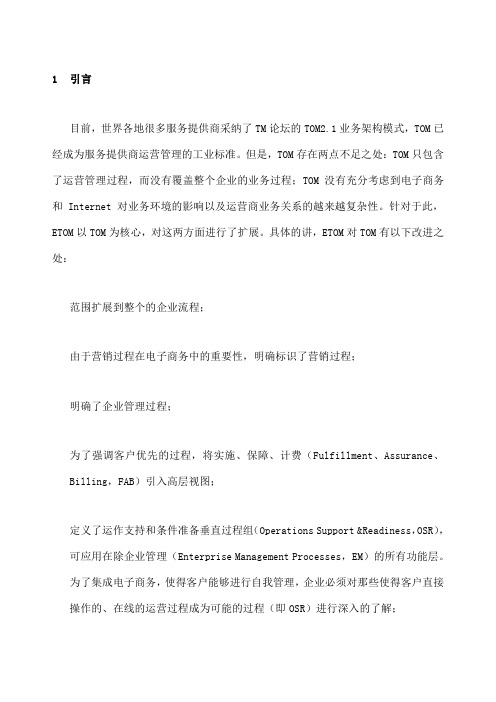
1引言目前,世界各地很多服务提供商采纳了TM论坛的TOM2.1业务架构模式,TOM已经成为服务提供商运营管理的工业标准。
但是,TOM存在两点不足之处:TOM只包含了运营管理过程,而没有覆盖整个企业的业务过程;TOM没有充分考虑到电子商务和Internet对业务环境的影响以及运营商业务关系的越来越复杂性。
针对于此,ETOM以TOM为核心,对这两方面进行了扩展。
具体的讲,ETOM对TOM有以下改进之处:范围扩展到整个的企业流程;由于营销过程在电子商务中的重要性,明确标识了营销过程;明确了企业管理过程;为了强调客户优先的过程,将实施、保障、计费(Fulfillment、Assurance、Billing,FAB)引入高层视图;定义了运作支持和条件准备垂直过程组(Operations Support &Readiness,OSR),可应用在除企业管理(Enterprise Management Processes,EM)的所有功能层。
为了集成电子商务,使得客户能够进行自我管理,企业必须对那些使得客户直接操作的、在线的运营过程成为可能的过程(即OSR)进行深入的了解;标识了战略、基础设施、产品过程(Strategy、 Infrastructure and Product,SIP),并将其分为三个垂直的过程组:战略(Strategy&Commit,SC)、基础设施生命周期管理(Infrastructure Lifecycle Management,ILM)、产品生命周期管理(Product Lifecycle Management,PLM)。
这些过程组与运营过程(OPS)具有不同的时间周期,OPS通常是每天的或每分的,而SIP通常具有较长的时间周期;由客户关怀或面向服务的方式转化为客户关系管理(Customer Relationship Management ,CRM)。
CRM强调以下几个方面:客户的自我管理和控制,增加有价值客户对企业的贡献;利用信息来为客户提供个性化服务。
eTom过程框架概述
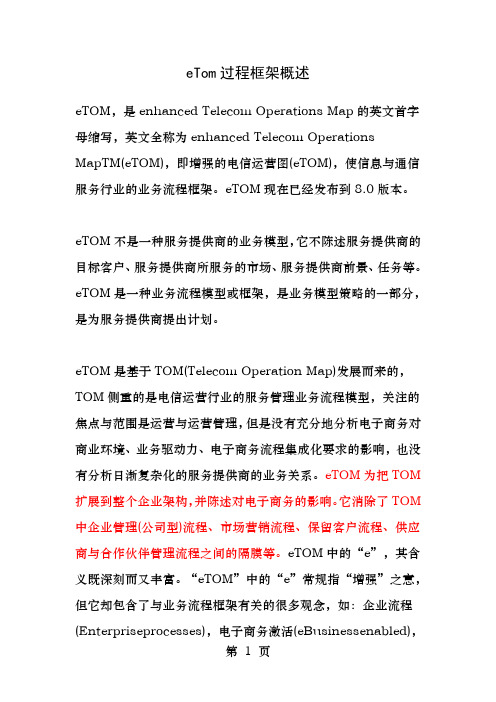
eTom过程框架概述eTOM,是enhanced Telecom Operations Map的英文首字母缩写,英文全称为enhanced Telecom Operations MapTM(eTOM),即增强的电信运营图(eTOM),使信息与通信服务行业的业务流程框架。
eTOM现在已经发布到8.0版本。
eTOM不是一种服务提供商的业务模型,它不陈述服务提供商的目标客户、服务提供商所服务的市场、服务提供商前景、任务等。
eTOM是一种业务流程模型或框架,是业务模型策略的一部分,是为服务提供商提出计划。
eTOM是基于TOM(Telecom Operation Map)发展而来的,TOM侧重的是电信运营行业的服务管理业务流程模型,关注的焦点与范围是运营与运营管理,但是没有充分地分析电子商务对商业环境、业务驱动力、电子商务流程集成化要求的影响,也没有分析日渐复杂化的服务提供商的业务关系。
eTOM为把TOM 扩展到整个企业架构,并陈述对电子商务的影响。
它消除了TOM 中企业管理(公司型)流程、市场营销流程、保留客户流程、供应商与合作伙伴管理流程之间的隔膜等。
eTOM中的“e”,其含义既深刻而又丰富。
“eTOM”中的“e”常规指“增强”之意,但它却包含了与业务流程框架有关的很多观念,如:企业流程(Enterpriseprocesses),电子商务激活(eBusinessenabled),扩展的(Expanded)每事(Everything)、每处(Everywhere)、每时(Everytime)等含义。
eTOM是一种业务流程模型或框架,它为服务提供商提供所要求的企业流程,但它不是业务模型。
它不陈述以下策略问题:谁是服务提供商的目标客户,服务提供商所服务的市场是怎样的,以及服务提供商的愿景如何、任务是什么等等。
eTOM较好地代表了电信运营业的真实世界,很多服务提供商(包括了系统集成商、ASP与软件供应商)已经在运用eTOM,因为他们在采购软件、设备,以及面对愈加复杂的业务关系网络中与其它服务提供商的接口,都需要行业的标准框架。
E-TOM简介

eTOM——电信运营业务流程国际规范 2003年8月19日 13:29 通信世界网中信公司管理信息中心王卫乡随着信息时代的到来,我国各行各业都面临着诸多机遇与挑战,党和政府适时地提出“以信息化带动工业化,发挥后发优势,实现社会生产力的跨越式发展”的伟大战略决策。
在近几年的信息化建设中,一些企业在企业信息化建设方面的投入较大,但收效甚微。
原因之一在于:缺乏统一的信息化框架、标准和规范。
在我国电子商务、电子政务全面发展之际,此框架、标准和规范就显得尤为重要,只有按照统一的框架、标准和规范,才可能避免重复建设、实现信息共享。
目前人们都把电信企业当作是信息化建设的排头兵,这隐含有四层意思:(1)电信企业是国家信息基础设施的主要建设者和运营者,担负着基础建设的重要使命;(2)电信业自身的信息化建设能够强化企业自身的管理规范,提高运营效率和综合竞争能力;(3)电信企业可以利用自身的信息化典范,为其他的企业提供信息化的解决方案,作为一种新的业务为客户提供更好的服务;(4)电信企业自身的信息化建设更具有推进社会信息化、政府信息化、企业信息化的示范作用。
信息化建设需要规范的业务流程和管理流程做基础,电信运营业务流程最新的国际规范eTOM3.0版对电信相关企业的信息化建设和企业运营至关重要。
一、eTOM中“e”的含义“eTOM”中的“e”常规指“增强”之意,但它却包含了与业务流程框架有关的很多含义,如:企业流程(Enterprise processes)、电子商务激活(eBusiness enabled)、扩展的(Expanded)、每事(Everything)、每处(Everywhere)、每时(Every time)等。
二、eTOM业务流程框架的目的eTOM业务流程框架作为电信运营业务流程的向导蓝图和业务及运营支撑系统(分别为BSS和OSS)发展和集成的始发点,有助于推动和发展NGOSS(Next Generation Operations Systems and Software,下一代运营系统和软件)解决方案。
基于eTOM和ITIL的运维流程管理体系探讨

基于eTOM和ITIL的运维流程管理体系探讨流程重组和信息化建设是当今企业的重头戏,企业在进行流程重组和信息系统建设的时候,行业标准具有重要的指导意义。
eTOM是电信管理论坛制定的针对电信行业的业务过程框架,是对电信企业经营管理活动的抽象和归纳,是电信企业的业务流程标准。
ITIL是企业内部IT部门用于进行IT系统运维管理的流程标准,是IT领域的最佳实践。
对于电信企业来说,如何应用eTOM和ITIL来建立自己的流程体系,打造一流的运维管理体制,是实现从优秀到卓越的关键;如何将国际规范最先进的技术和管理理念运用在企业实践中,打造一流的运营支撑系统,是提高核心竞争力的关键。
一、eTOM与ITIL简介eTOM(enhancedTelecomOperationMap)增强的电信运营图,是电信管理论坛TMF制定的一个针对电信企业的业务过程标准,是由世界上众多电信运营商、软件开发商、系统集成商和通信设备提供商根据实践提炼、总结出来的一套适用于电信行业的业务过程框架,是对电信企业业务活动和经营行为的抽象和归纳,是电信行业标准。
它从业务的视角对电信企业的经营活动进行了整体描述,它将企业环境分为三个部分,分别是战略、基础设施和产品过程域(SIP)、运营过程域(OPS)和企业管理过程域(EM),如图1所示。
战略、基础设施和产品过程域指导和使能运营过程域,包括策略的开发、基础设施的构建、产品的开发和管理、供应链的开发和管理。
运营过程域是eTOM的核心,它既包括日常的运营支撑过程,如从前台到后台的开通、保障和计费端到端的流程组,也包括为这些运营支撑提供条件的准备过程以及销售管理和供应商、合作伙伴关系管理。
企业管理过程域则包含了运作和管理一个大型企业所需要的基本业务过程。
eTOM横向分为四个功能组,由上到下分别是营销、产品提供和客户关系管理,业务开发管理与运营,资源开发管理与运营,供应链开发管理和供应商合作伙伴关系管理;纵向分为七个端到端流程,分别是战略、基础设备生命周期管理、产品生命周期管理、运营支持与就绪、实施、保障和计费。
eTOM

Resource Development & Management (Application, Computing and Network)
Supply Chain Development & Management
Resource Management & Operations (Application, Computing and Network)
Network Provisioning
Network Inventory Management
Network Maintenance &
Restoration
Network and Systems Management Processes
Network Data Management
Network Element Management Processes Physical Resource and Information Technology
Financial & Asset Human Resources
Management
Management
Stakeholder & External Relations Management
Research & Development, Technology Acquisition
Disaster Recovery, Security & Fraud Management
Service Dev elopment and Op'ns Ma n a gement
Resource Inf ras'ture Dev't and Mn g mnt
欧框语言框架标准
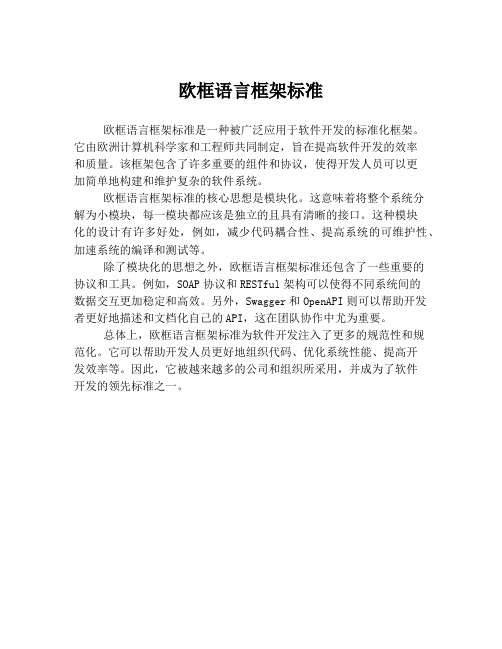
欧框语言框架标准
欧框语言框架标准是一种被广泛应用于软件开发的标准化框架。
它由欧洲计算机科学家和工程师共同制定,旨在提高软件开发的效率
和质量。
该框架包含了许多重要的组件和协议,使得开发人员可以更
加简单地构建和维护复杂的软件系统。
欧框语言框架标准的核心思想是模块化。
这意味着将整个系统分
解为小模块,每一模块都应该是独立的且具有清晰的接口。
这种模块
化的设计有许多好处,例如,减少代码耦合性、提高系统的可维护性、加速系统的编译和测试等。
除了模块化的思想之外,欧框语言框架标准还包含了一些重要的
协议和工具。
例如,SOAP协议和RESTful架构可以使得不同系统间的
数据交互更加稳定和高效。
另外,Swagger和OpenAPI则可以帮助开发者更好地描述和文档化自己的API,这在团队协作中尤为重要。
总体上,欧框语言框架标准为软件开发注入了更多的规范性和规
范化。
它可以帮助开发人员更好地组织代码、优化系统性能、提高开
发效率等。
因此,它被越来越多的公司和组织所采用,并成为了软件
开发的领先标准之一。
- 1、下载文档前请自行甄别文档内容的完整性,平台不提供额外的编辑、内容补充、找答案等附加服务。
- 2、"仅部分预览"的文档,不可在线预览部分如存在完整性等问题,可反馈申请退款(可完整预览的文档不适用该条件!)。
- 3、如文档侵犯您的权益,请联系客服反馈,我们会尽快为您处理(人工客服工作时间:9:00-18:30)。
包括企业基础设施的开发 和管理,这些设施为产品 或为企业本身提供支持 处理企业与其它提供商和 合作伙伴的交互。包括支 持产品和基础设施的供应 链管理,以及与其他提供 商和合作伙伴之间关于日 常运营的接口的管理
2
强调企业层面的过 程目标。包括任何 商业运行必须的基 本业务过程。与企 业中几乎所有的其 它过程都有接口
S/PRM支持和流程管理的Level3视图
S/PRM人 员支持和 调度
S/PRM工 作场所设 备管理
S/PRM过 程监控
S/PRM项 目管理
S/PRM运 营成本监 控
S/PRM运 营系统和 通信支持
S/PRM运 营质量和 性能管理
5
作为一个被电信行业广泛接受和认可的流程模型,公司应把e-TOM与实际 相结合, 参考但不完全拘泥于e-TOM,形成具有自身特色的流程框架(模型) 示例:一个简化后的e-TOM业务模型
D.供应链规划
D-1.供应 链战略 D-2.采购 规划 D-3.采购管理 D-4.供应链开发
H.供应商和合作伙伴关系管理
H-1.供应商关系管理 H-2.合作伙伴关系管理
企业管理
I.战略和企业规划
I-1.战略 管理 I-2.经营 计划 I-3.组织 规划 I-4.集团 企业管 理
II.财务与资产管理
II-1.预算 和控制 II-2.资本 II-3.运营 II-4.财务 II-5.会计 投资管 资金管 分析 核算 理 理
3
2级视图是对1级流程的进一步细化
e-Tom二级视图
战略、基础设施和产品 运营
企业管理
4
3级视图是对2级视图中的运营部分水平层次的进一步分解
OSR Level3层的分解覆盖了运营过程的四个水平的功能层次:客户关系管理(CRM)、业务管理 和运作(SM&O)、资源管理和运作(RM&O)、供应商和合作伙伴关系管理(S/PRM)
VI.企业形象管理
VI-1.企业形象管理
VII.外部关系管理
VII-1.公共 关系(媒 体管理 VII-2.股 东关系管 理 VII-3.政府 监管和法 律法规
VIII.企业风险管理
VIII-1.企 业应急计 划 VIII-2.安 全管理 VIII-3.欺 诈管理 VIII-4. 企业内部 审查管理 VIII-5.保 险管理
eTOM框架性介绍
1
e-TOM的0级视图界定了公司运作的 三个流程领域:战略,运营及企业管理
e-TOM: 增强的电信运营图(enhanced Telecom Operations Map)
ETOM Level0视图(又称概念层框架)对服务提供商的企业环境进行了整体的描述 ETOM被分为三个主要的范围和四个水平的层次 包括销售和渠道管理、营销管理、 产品和定价管理,客户关系管理、 问题处理、SLA管理、计费等
6
流程诊断和设计方法一般采用自上而下,层层深入的 方式,根据问题的性质恰当地确定诊断和设计的层次
客户
战略,基础设 施&产品
运营
市场,产品和客户 服务 资源(应用,计算和网络) 供应商/合作伙伴 供应商/合作伙伴 企业管理
流程 领域
战略、基础设施和产品
客户 基础设施生命周期管理
产品和定价 营销能力提供 能力提供 能力 构建和提供
战略
产品生命周期管理
产品推出和 退出 销售和渠道 开发 营销活动和 促销活动 产品、营销和客 户行为分析
营销和定价管理
股东
员工
Stakeholders
市场战略策略 产品及其价 格商务计划 产品及其价格 组合策略 业务开发管理
客户 战略、基本架构和产品
1、战略 落实管理 A、市场营销
A -1.客户细分和 价值定位
运营
3、产品 生命周期管理
A -2.新产品开发 A -3.定价 A -4.渠道管理 A -5.营销宣传
2、基础架构 生命周期管理
4.运作 支持和就绪 E.客户关系管理
5.业务实现
6.业务保障
7.计费与帐务
E-1. 集团客户管理 E-2. 个人客户管理
III.人力资源管理
III-1. 组 织结构和 岗位设计 III-2. 招 聘 III-3.人员与 岗位安排 III-4.员 工职业 发展 III-5.个人 业绩考核 与薪酬
IV.研发与技术 引进
IV-1. 研发 IV-2. 技 术引进
V.企业效率管理
V-1. 企 业质量 管理 V-2. 流程管 理 V-3. V-4. IT IT规划 运维 V-5. 知识管 理
股东
员工
Stakeholders
将0级视图三个流程领域分解为1级视 图,形成公司运作的最高层次的流程
e-Tom一级视图
ETOM Level0视图可进一步 被细化为Level1视图(CEO 视图) 在Level1视图中运营过程 (OPS)和战略、基础设施和 产品过程(SIP)被分解为 七个垂直的过程组和八个 水平的过程组,而企业管 理过程(EM)被分为八个 过程组 垂直的过程分组:该分组 描述了端到端的过程,如 整个的计费流程所涉及的 过程 水平的过程分组:描述了 面向功能的过程,如管理 供应链所涉及的过程
B.内部服务协议设计与开发
B-1.内部服务协议设计与开发
F.内部服务管理与运作
F-1.内部服务运作与保障
C.网络资源建设
C-1.网络投资计划 C-2.网络设计管理 C-3.网络采购管理 C-4.网络建设和 更新管理
G.网络资源调度
G-1.资源调配 G-2.应急建设
G-3.备件管理 G-4.运行维护
G-5.资源信息管理
销售和渠道管理的Level3视图
CRM运作支持和流程管理的Level3视图
销售和渠道管理
CRM运作支持 和流程管理
渠道管理 销售管理
CRM 人 员支持 和安排
CRM 设 备支持
CRM 运 营系统 和通讯
CRM 项 目管理
CRM 运 作成本 控制
CRM 流 程控制
CRM运作 质量性能 管理
S/PRM支持和流程管理
ETOM的核心。包括日常运营 支撑及其准备过程、销售管理 和供应商/合作伙伴关系管理 客户
包括策略的开发、 基础设施的构建、 产品的开发和管理、 供应链的开发和管 理
战略,基础设 施&产品
运营
市场,产品和客户 服务 资源(应用,计算和网络) 供应商/合作伙伴 供应商/合作伙伴 企业管理
包括业务的开发和配置、 业务问题管理和质量的分 析、业务使用量的计费等
